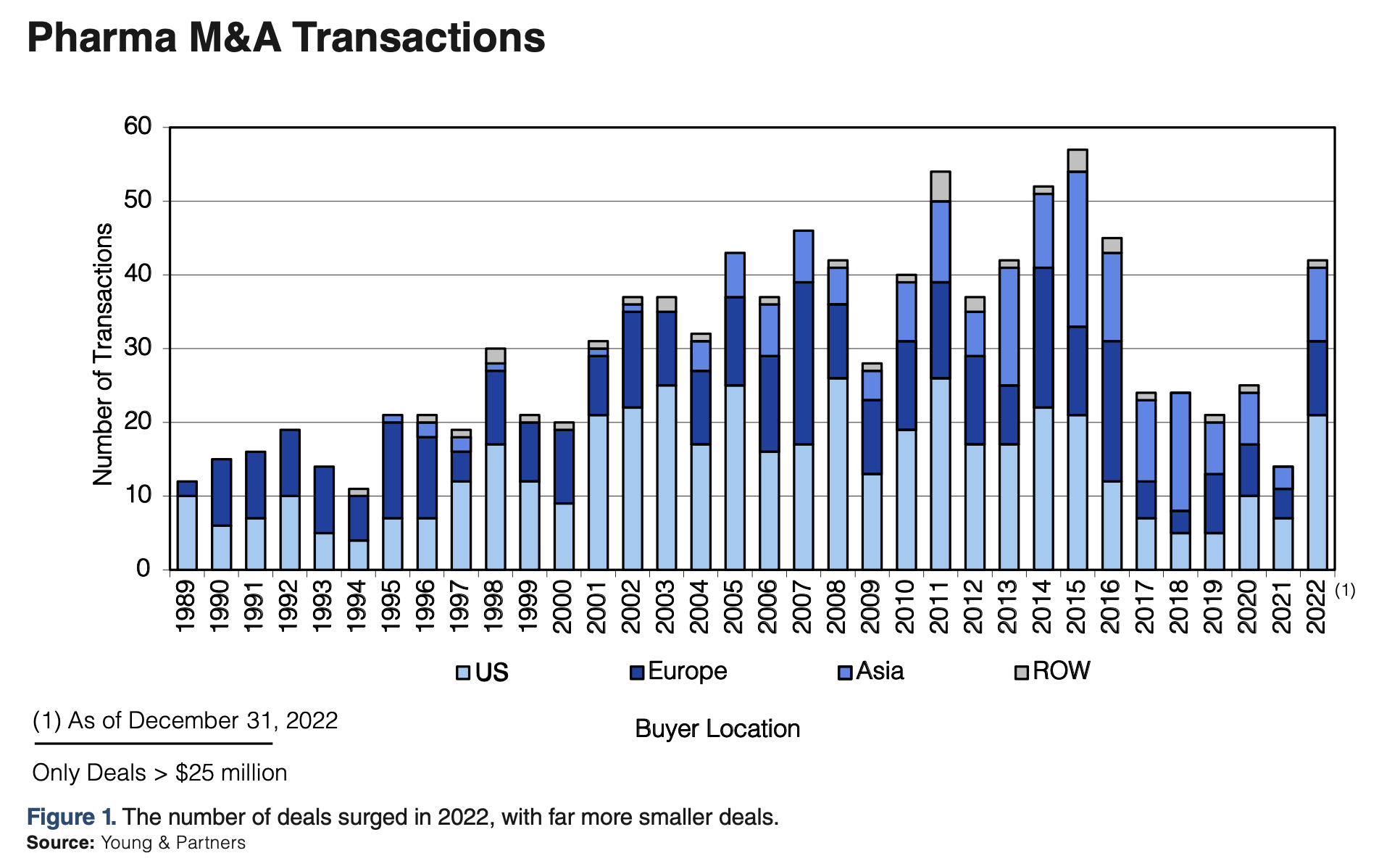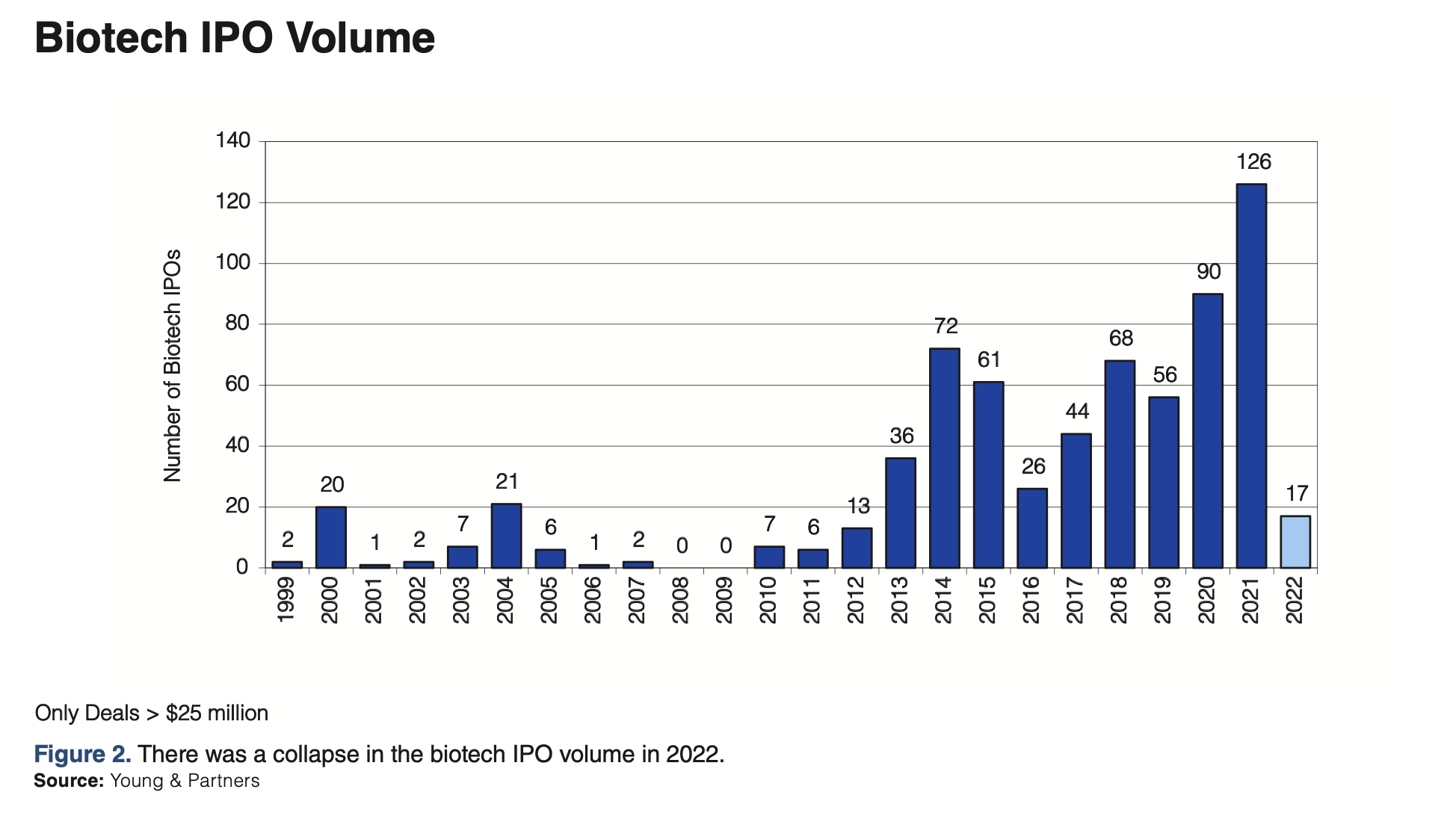- Sustainability
- DE&I
- Pandemic
- Finance
- Legal
- Technology
- Regulatory
- Global
- Pricing
- Strategy
- R&D/Clinical Trials
- Opinion
- Executive Roundtable
- Sales & Marketing
- Executive Profiles
- Leadership
- Market Access
- Patient Engagement
- Supply Chain
- Industry Trends
Biopharma M&A: Year in Review, Ripples Ahead
While industry financial markets continued to experience subdued dollar volumes in 2022, dealmaking held steady—with factors such as pharma pursuing strategic priorities and biotech funding woes playing major roles.

Pharmaceutical and biotechology merger and acquisitions in 2022 were heavily driven by strategic priorities, business trends, and the stock market performances of the two sectors. These factors are also driving the outlook for 2023.
Although the pace of innovation was strong for both pharma and biotech companies, their financing and stock market situations could not have been more divergent in 2022. Although there was a slight improvement in the early part of 2023, there was a huge decline in the biotech stock market prices, the number of initial public offerings (IPOs), the number of secondary offerings, and the market values of biotech companies in 2022. For example, according to Young & Partners data analyses, the number of IPOs dropped from 126 in 2021 to 17 in 2022. This made it much harder to raise money for public and private biotech companies.
Many biotechs that had plans to go public have been experiencing serious funding problems since the IPO market has been an important source of attractive equity funds to extend their research and regulatory runways and to provide a way for the private owners to achieve liquidity. The suppressed market values and the plunge in public offerings have driven many to sell themselves earlier and to pursue strategic partnerships with other companies.
The huge drop in biotech stock market valuations and IPOs has also pushed down the private equity funding valuations and availability. Venture capital firms took big paper losses on the existing ownership positions in private and public biotech/biopharma companies and are cautious about making new investments in private companies if there is an uncertain route to an IPO.
With many of the private biotechs running out of money, downsizing announcements will continue to be seen on a regular basis. Some of the biotech companies will not survive and will have to shut down. This down cycle has happened to biotech many times historically; so, this is not a new development in the history of the industry. Unfortunately, downturns generally last a number of years before there is a recovery.
Collectively, business uncertainties and the difficult public and private equity markets have had an impact on the biotech M&A market with regard to the value expectations of sellers and buyers. On the other hand, pharma company shares did quite well in the stock market on both an absolute and general relative basis. Pharma M&A has been a more normal function of pharma company business strategies. Although the big pharma organizztions have revived their ability to invent new drugs, they still need to supplement their own efforts with acquisitions of and collaborations with mid-sized pharma and biotech companies. This is particularly true for manufacturers facing patent cliffs for their major drugs.
The rest of this article focuses on pharma and biotech M&A activity. All the numbers cited are Young & Partners proprietary data.
Pharma M&A market: 2022 recap, 2023 outlook
In 2022, the dollar volume of pharma deals was about the same as the year before—$59.9 billion vs. $61.2 billion in 2021. However, there was a remarkable increase in the number of deals, from only 14 in 2021 to 42 in 2022. The average deal size dropped from $4.4 billion to $1.4 billion. Biotech deals are not included in these numbers. This shift to a large number of medium-sized deals is a reflection of a number of driving factors.
Big pharma’s balance sheets and cash flows are strong in general. As such, they have a great deal of dry powder. However, their more selective, cautious acquisition of medium- to small-size pharma companies reflects 1) concerns about the overall business environment; 2) a move away from mega deals; and 3) access to a wide variety of other strategic asset avenues, such as biotech acquisitions, partnering, and in-licensing.
Big pharma companies have rightly come to realize that mega mergers/acquisitions are less effective compared to targeted acquisitions of pharma companies for a specific strategic purpose. The mega deals in the past did have significant cost synergies. But for the most part, it did not drive an increase in innovation and research results.
The M&A market outlook for pharma deals this year will likely be very strong in terms of the number of deals and flat to slightly up in terms of dollar volume. The only possible exception will be if one of the regional global players does a large deal in order to change its geographic profile. The driver of activity will remain the same as in 2022.

Biotech M&A market: 2022 recap, 2023 outlook
In 2022, 45 biotech deals worth $24 billion were completed, as compared to 48 deals worth $27 billion finalized in 2021—representing modestly lower numbers in terms of the amount and dollar volume of deals. There were no large transactions, except for Pfizer’s $6.2 billion acquisition of Arena Pharmaceuticals.
Although the industry is well off the record dollar volume of $53 billion that was set in 2020, the last two years have been the highest in years in terms of the number of deals completed. The next highest year over the last 30 was 2016, when 35 deals closed.
What is driving this trend? First of all, most of the acquisitions are being executed by pharma companies who are looking to build their pipelines and revenues. Second, with the collapse of the IPO market, a severe reduction in equity funding, and a dramatic drop in the share prices of biotech companies, the latter are more willing to consider a sale of the company at an earlier stage than they were just a year and a half ago. Third, pharma organizations are using strategic partnerships and licensing to access biotech company technologies and drug candidates. Thus, M&A is not the sole method available to achieve pharma company goals.
What is the outlook for biotech M&A in 2023 and beyond? Expect more of the same in the future, driven by the same factors, with a relatively robust number of biotech deals being completed for the next couple of years, along with strategic partnerships and licensing.
How will senior management approach M&A in this environment?
Big Pharma management will be heavily focused on acquisitions for which there are compelling strategic reasons and where the same results cannot be obtained internally or through licensing and strategic partnerships. There will be a particular focus on targeting companies with synergistic technologies and drug candidates and new technologies deemed to be strategically critical to add.
However, it will be challenging to determine what the right valuations are for each deal. With the collapse of the public market values for biotechs and the downward repricing of private biotech companies in down rounds, matching buyer and seller expectations will be a challenge. The use of earn-outs has ballooned in the last couple of years as a way to bridge the gap between buyer and seller value expectations.
Separately, there are pharma companies facing major revenue shortfalls due to patent expirations and geographic pressures faced by non-Western players who are too dependent on their home countries, such as organizations in Japan and South Korea.
Regulatory restrictions, such as the expanded CFIUS rules that impose serious review requirements for Chinese companies and investors seeking ownership of US pharma and biotech companies, will continue and inhibit those deals. Similarly, movements by foreign organizations and investors in China are being constrained by the uncertainties related to Chinese government regulation and controls around a variety of industries, such as healthcare.

Geographic considerations for the M&A market
The largest volume of M&A deals in biotech was in the US, accounting for 31 of the 45 deals in 2022. As we know, the biotech industry started in the US, and the US has had the best overall ecosystem to support biotechnology drug innovation for many decades. For that reason, the US is home to the largest number of biotechs by far; therefore, one would expect greater M&A activity in North America The rest of the deals have been primarily in Europe. Very few biotech and pharma deals are being executed in Asia and the rest of the world, but this will change over time as biotech activity in Asia continues to expand.
The picture, surprisingly, has been different in pharma, with Europe equaling the US as the location where deals were completed. In 2022, 15 deals were completed in Europe, compared to 18 in the US. Traditionally, Big Pharma has been far more diverse geographically compared to biotech.
The potential impact of economic and geopolitical trends
Although we may be facing recessions in many global regions (particularly in the EU and emerging markets), no one expects the downturn to last for a long time. As we all know, pharmaceuticals are much less cyclical than most industries. Although the war in Ukraine and the geopolitical tensions between the West and China have become severe, these factors will not have a dramatic effect on pharmaceutical demand or strategies.
Although the biopharma industry is facing a few challenges that are global in nature, such as the ongoing challenges related to supply chain problems and the disruption that zero COVID-19 policies in China and the war in Ukraine have had on clinical trials, most of the challenges are industry specific. Examples include the sector’s dependence on China and India for many active pharmaceutical ingredients and drug production of certain products, the ongoing efforts globally to constrain drug pricing, and the rapidly changing technologies related to drug discovery innovation. These industry-specific challenges will have a major effect over time on pharma and biotech companies and the role that M&A will play in their strategic plans.
Peter Young, CEO and president of Young & Partners, and a member of Pharm Exec’s Editorial Advisory Board. He can be reached at pyoung@youngandpartners.com.

Transforming Cancer Care: Data, AI, and Patient-Centered Care
July 20th 2023Join us as Mohit Manrao, SVP and head of US oncology at AstraZeneca, shares his patient-centered approach to transforming cancer care, bridging the gap between innovative science and tangible patient outcomes across all populations on a global scale.
